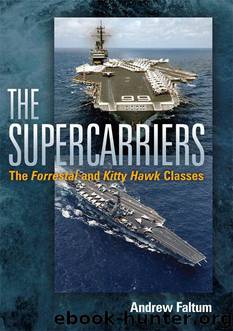The Supercarriers: The Forrestal and Kitty Hawk Classes by Andrew Faltum

Author:Andrew Faltum [Faltum, Andrew]
Language: eng
Format: epub
ISBN: 9781612517704
Publisher: Naval Institute Press
Published: 2014-11-15T08:00:00+00:00
F/A-18 Hornet and Super Hornet
The Navy had wanted a multirole aircraft to replace the A-4 Skyhawk, the A-7 Corsair, and the remaining F-4 Phantoms, as well to complement the F-14 Tomcat. Congress had mandated that the Navy find a lower-cost alternative to the F-14, but both Grumman and McDonnell Douglas had submitted proposals that were nearly as expensive as the F-14. In 1973 Defense Secretary James Schlesinger ordered the Navy to evaluate the competitors in the Air Force Lightweight Fighter (LWF) program, the General Dynamics YF-16 and Northrop YF-17. The Air Force adopted the F-16, but the Navy preferred the twin-engine F-17. Northrop partnered with McDonnell Douglas to develop an essentially beefed up version of the F-17 that became the F-18 Hornet, which first flew in 1978. Fighter and attack versions of the basic aircraft subsequently emerged as the F/A-18A single-seat version, which entered service in 1983, and the F/A-18B two-seat version, which was primarily used for training. The F/A-18 first saw combat action in April 1986 against Libyan air defenses during Operation Prairie Fire and an attack on Benghazi as part of Operation El Dorado Canyon. In 1987 the Hornet was upgraded to the F/A-18C (single-seat) and F/A-18D (dual-seat) versions. (The Hornet is currently in service with the Navy and Marines as well as Australia, Canada, Finland, Kuwait, Malaysia, Spain, and Switzerland.) When the Navy A-12 Avenger II program, intended to replace the A-6 Intruder, was canceled, the Super Hornet was selected to fill the gap. Designed and initially produced by McDonnell Douglas, the Super Hornet first flew in 1995. Full production began in 1997, after the merger of McDonnell Douglas and Boeing. The F/A-18E single-seat and F/A-18F dual-seat variants are essentially larger and more advanced derivatives of the F/A-18C and D Hornet. The Super Hornet can carry up to five external fuel tanks and can be configured as an airborne tanker to replace the KA-6D. Entering service in 1999, the Super Hornet began replacing the F-14 Tomcat in 2006, and serves alongside the original Hornet in carrier air wings.
Download
This site does not store any files on its server. We only index and link to content provided by other sites. Please contact the content providers to delete copyright contents if any and email us, we'll remove relevant links or contents immediately.
Small Unmanned Fixed-wing Aircraft Design by Andrew J. Keane Andras Sobester James P. Scanlan & András Sóbester & James P. Scanlan(32764)
Navigation and Map Reading by K Andrew(5133)
Endurance: Shackleton's Incredible Voyage by Alfred Lansing(4719)
And the Band Played On by Randy Shilts(2166)
The Box by Marc Levinson(1965)
Top 10 Prague (EYEWITNESS TOP 10 TRAVEL GUIDES) by DK(1958)
Wild Ride by Adam Lashinsky(1951)
The Race for Hitler's X-Planes: Britain's 1945 Mission to Capture Secret Luftwaffe Technology by John Christopher(1837)
The One Percenter Encyclopedia by Bill Hayes(1811)
Trans-Siberian Railway by Lonely Planet(1725)
Girls Auto Clinic Glove Box Guide by Patrice Banks(1707)
Bligh by Rob Mundle(1677)
Looking for a Ship by John McPhee(1651)
Good with Words by Patrick Barry(1641)
Batavia's Graveyard by Mike Dash(1633)
TWA 800 by Jack Cashill(1626)
Fighting Hitler's Jets: The Extraordinary Story of the American Airmen Who Beat the Luftwaffe and Defeated Nazi Germany by Robert F. Dorr(1611)
Troubleshooting and Repair of Diesel Engines by Paul Dempsey(1578)
Ticket to Ride by Tom Chesshyre(1567)
